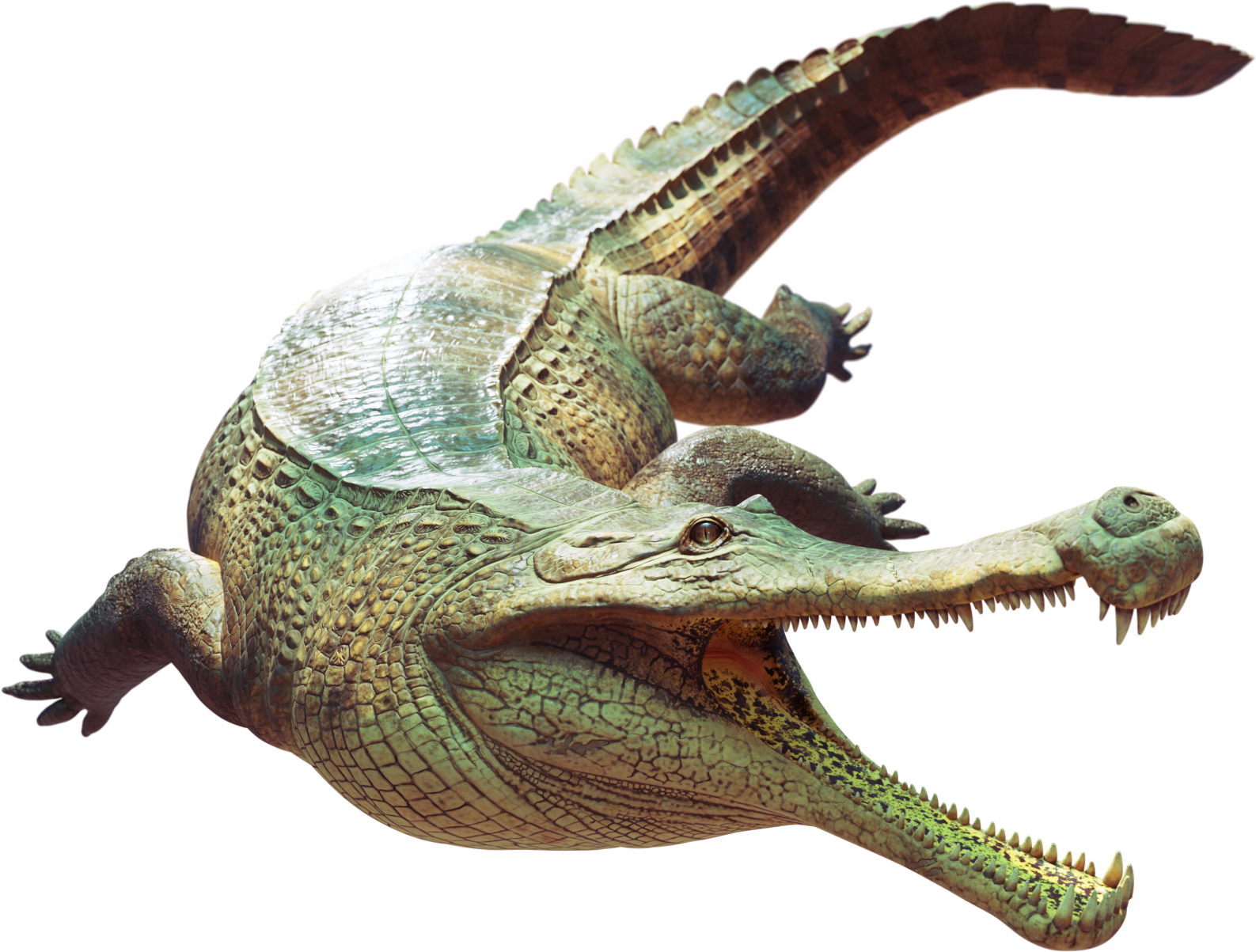The Super-Croc of the South
This super-sized croc-cousin was the ruler of the waterways of Early Cretaceous Africa and South America, and is still one of the largest known crocodiliformes!
Overview: During the Early Cretaceous, the southern hemisphere wasn't just home to ferocious dinosaurs, but also super-sized crocodile relatives like Sarcosuchus, recognizable for its enormous size and elongated snout. Discovered in the mid-19th Century in Niger, Sarcosuchus is still one of the largest known croc-relatives of all time! It ruled the rivers and estuaries it called home, where it would have competed with dinosaurs like Suchomimus.
Discovery: The holotype (original) specimen of Sarcosuchus imperator was found in the Elrhaz Formation of Niger in 1964. Previous to this discovery, fragmentary remains of giant crocodyliforms had been discovered in Mali and Tunisia, which might have belonged to Sarcosuchus. Sarcosuchus was described and named based on the Niger material, a nearly complete skull, by France De Broin and Phillipe Taquet in 1966. Sarcosuchus means “flesh crocodile” from Greek “sarx”, meaning flesh, and “souchus”, meaning crocodile, and imperator is Latin, a title meaning “commander in chief”, given to generals in the Roman Republic, and later identified with the Roman Emperor, in fact coming to mean, and being the original source of the word “emperor”. Thus, Sarcosuchus imperator is the “Emperor Flesh Crocodile”. Since its naming, additional specimens have been discovered, including a second species, Sarcosuchus harti from Brazil, and material from the Kem Kem Beds of Morocco which may belong to Sarcosuchus, and if so, would extend its temporal range to the Cenomanian age (98-92.5 Ma). Fragmentary remains from Libya may be Sarcosuchus, and if so, would push its temporal range as far back as 133 million years ago. This actually makes sense as the Brazilian species is that old.
Evolution and Description: Sarcosuchus is a relative of crocodilians, which it closely resembled. Crocodiles and their relatives are contained in the clade Crocodylomorpha. Within this clade, Sarcosuchus belongs to the clade Neosuchia, which includes most croc-like croc-relatives, that is, those that physically and ecologically resemble modern crocodilians, i.e. short legs, osteoderms (armor plates in the skin) on the back, flattened skull, long snout, semi-aquatic. Within this group Sarcosuchus was in the family Pholidosauridae, a family of narrow-snouted croc-relatives. However, Sarcosuchus was much larger than other pholidosaurs, with a more robust snout. Overall, Sarcosuchus looked like a giant crocodile. It grew to be 9 to 9.5 m (29.5 to 31.2 ft) long and weighed around 3.45-4.3 tonnes (3.80-4.74 tons), one of the biggest crocs of all time, though there were a few others that were still bigger. The skull of Sarcosuchus resembled a robust version of a modern gharial, with a long, proportionally thin snout that widened slightly at the tip. Like male gharials, Sarcosuchus had a structure called a bulla, which made it look like it had a swollen nose. Like crocodilians, Sarcosuchus had osteoderms covering its neck and back, however these were arranged in a different pattern than modern crocs. While modern crocs have discontinuity between the armor on the neck and back, the osteoderms of Sarcosuchus formed an uninterrupted surface from neck to tail.

Ecology: Sarcosuchus lived in north Africa 112 million years ago. Where now there is the Sahara Desert, then it was a much wetter environment with abundant rivers. While theropods like Eocarcharia and Kryptops dominated terrestrial predator niches, Sarcosuchus was the “imperator” of the rivers. It probably ate whatever it could catch. Its long jaws meant that large fish probably made up the bulk of its diet. Abundant fish included Lepidotus and the large coelacanth Mawsonia. Sarcosuchus may have also been a shoreline ambush predator like any modern crocodiles. This means dinosaurs such as the sail-backed iguanodont Ouranosaurus could have been on the menu. However, a biomechanical analysis of the skull of Sarcosuchus suggests that it would have been unable to perform the “death roll” maneuver that allows modern crocodilians to dismember and disembowel large prey. This means that Sarcosuchus may have taken such large prey less frequently than modern crocodiles, or else had a different, currently unknown method of breaking up a carcass. Sarcosuchus would have shared the river with the spinosaurid Suchomimus, which was probably a shoreline predator, like a giant heron. This may have brought them into competition, as they may have been hunting similar prey.
Extinction and Legacy: Why Sarcosuchus went extinct is unknown. Assuming all fragmentary referred remains do indeed belong to Sarcosuchus, it had a temporal range of possibly 36 million years (133-97 Ma) an extremely impressive evolutionary run! It is unclear if it survived later into the Cenomanian age (98-92 Ma). If not, it could have disappeared due to competition from Spinosaurus which appeared in the Cenomanian. If it did survive until the end of the Cenomanian then it may have fallen victim to the same set of extinctions the wiped out both carcharodontosaurids and spinosaurids, along with many other groups. Additionally, true crocodilians appeared about 94 million years ago, and competition from them may have contributed to the decline in other neosuchians like Sarcosuchus. Today, Sarcosuchus can be seen in the Muséum National d'histoire Naturelle, in Paris, France, and the Indianapolis Children's Museum in Indianapolis, Indiana, USA. Sarcosuchus has made appearances in the 2001 National Geographic documentary SuperCroc, the 2003 Animal Planet documentary Giant Monsters, and the 2011 BBC documentary Planet Dinosaur. The South American species was briefly featured in the 2002 BBC documentary Chased by Dinosaurs.
Sarcosuchus FAQ
Sarcosuchus size / How big was Sarcosuchus?
See weight and length.
Sarcosuchus weight / How much did Sarcosuchus weigh?
Sarcosuchus probably weighed around 3.45-4.3 tonnes (3.80-4.74 US tons)!
How long was Sarcosuchus?
Sarcosuchus was about 9 to 9.5 m (29.5 to 31.2 ft) long.
What did Sarcosuchus eat?
Sarcosuchus was an apex river predator, consuming fish and other animals, possibly including dinosaurs!
What is Sarcosuchus’s closest living relative?
The closest living relatives of Sarcosuchus are crocodilians like alligators and crocodiles.
Sarcosuchus family members / Sarcosuchus family / What kind of animal was Sarcosuchus?
Sarcosuchus was in the extinct family Pholidosauridae, a family of crocodile-relatives in the clade Crocodiliformes which also includes crocodilians.
Where did Sarcosuchus live? / Where was Sarcosuchus found?
Sarcosuchus imperator lived in north Africa, and its remains have been found in Niger, and possibly Morocco, Libya, and Tunisia as well.
When did Sarcosuchus live?
Sarcosuchus lived about 112 million years ago during the Early Cretaceous Period.
What does Sarcosuchus mean? / Sarcosuchus name meaning
Sarcosuchus means “flesh crocodile”.

